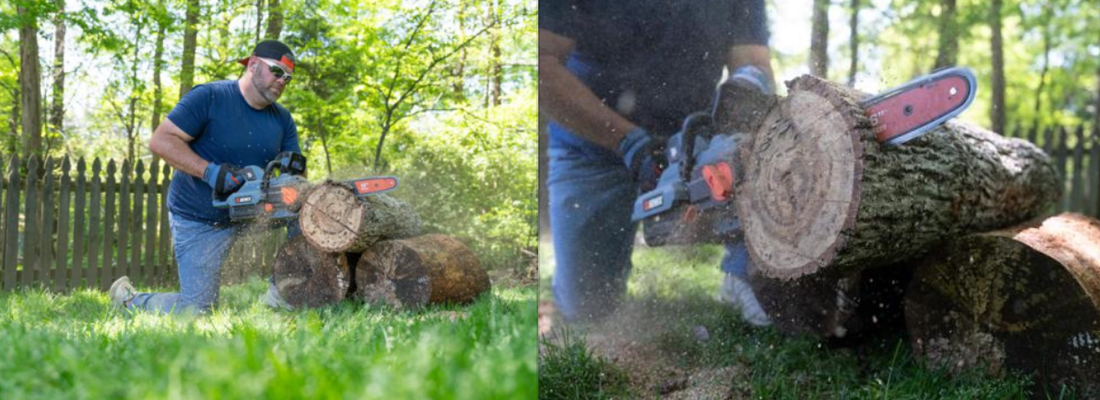Chainsaw Maintenance Guide
Chain saws make heavy duty yard work a breeze. Regular maintenance will keep your cordless chain saw running properly and safely while extending its lifespan. Keep your chain saw running well for as long as possible. Read a comprehensive guide on chain saw maintenance and learn new tips to maximize the life of your tool.
1. Regular Inspection: Before each use, conduct a thorough inspection of your chainsaw:
Visual Check: Look for any visible damage to the chainsaw body, handle, and safety features.
Chain Condition: Ensure the chain is not worn, damaged, or excessively stretched.
Bar Examination: Inspect the guide bar for any signs of wear or damage.
2. Chain Maintenance: The chain is a critical component that requires regular attention:
Sharpening: A sharp chain ensures efficient cutting and reduces strain on the engine. Use a round file or a chainsaw sharpener to maintain the chain's sharpness.
Tension Adjustment: Check and adjust the chain tension before each use. A properly tensioned chain prevents derailment and ensures smooth operation.
Cleaning: Remove sawdust and debris from the chain after each use to prevent buildup that can affect performance.
3. Guide Bar Care: The guide bar directs the chain and should be maintained carefully:
Cleaning the Groove: Remove the chain and clean the bar's groove to eliminate debris that can hinder chain movement.
Edge Maintenance: Inspect the bar edges for burrs and file them down if necessary to ensure the chain moves smoothly.
Sprocket Inspection: Check the sprocket at the bar's end for free movement, as a jammed sprocket can impede chain movement.
4. Air Filter Maintenance: A clean air filter ensures proper engine ventilation:
Inspection: Regularly remove and inspect the air filter for dirt and debris.
Cleaning: Wash reusable filters with soap and water, then allow them to dry completely before reinstallation.
Replacement: Replace damaged or excessively dirty filters to maintain engine efficiency.
5. Fuel System Care: Proper fuel maintenance prevents starting issues and engine problems:
Fuel Quality: Use fresh fuel mixed with the appropriate oil ratio as specified in the user manual.
Storage: If storing the chainsaw for an extended period, drain the fuel tank or add a fuel stabilizer to prevent fuel degradation.
6. Spark Plug Maintenance: The spark plug is vital for engine ignition:
Inspection: Check the spark plug for wear, carbon buildup, or damage.
Cleaning: Gently clean the spark plug electrode with a wire brush to remove debris.
Replacement: Replace the spark plug annually or as recommended in the user manual to ensure reliable starting.
7. Lubrication: Proper lubrication reduces friction and wear:
Bar and Chain Oil: Always use the recommended bar and chain oil to lubricate the chain and bar during operation.
Oil Level: Regularly check and maintain the oil reservoir to ensure continuous lubrication.
8. Cleaning After Use: Keeping your chainsaw clean prevents debris buildup and potential overheating:
Exterior Cleaning: After each use, remove sawdust, dirt, and sap from the chainsaw's exterior using a brush or cloth.
Air Filter Cleaning: Clean the air filter as described above to prevent engine strain.
9. Storage Tips: Proper storage extends the life of your chainsaw:
Indoor Storage: Store the chainsaw in a dry, cool place away from direct sunlight and moisture.
Protective Covering: Use a protective cover to shield the chainsaw from dust and environmental elements.
Fuel Management: As mentioned, drain fuel or use a stabilizer if storing for extended periods.
For DC Chain Saws (Lithium-Battery Powered): Remove the battery after use and store it in a cool place. Ensure the battery charge is at a moderate level before storage.
For Chain Saws with Brake Function: Always engage the brake when not in use to prevent accidental injuries.
Long-Term Storage Tips: Empty the grease box to avoid seal aging and deterioration.
10. Professional Servicing: While regular at-home maintenance is crucial, periodic professional servicing ensures comprehensive care:
Annual Check-Up: Have a professional inspect and service your chainsaw annually to address any issues not visible during routine checks.
Component Replacement: Replace worn or damaged parts promptly to prevent further damage and maintain safety.
By incorporating these maintenance practices into your routine, you ensure that your chainsaw remains a reliable and efficient tool, ready to tackle tasks safely and effectively. Always refer to your chainsaw's user manual for specific maintenance guidelines and intervals, as recommendations may vary by model.


 (5.0)
(5.0)


